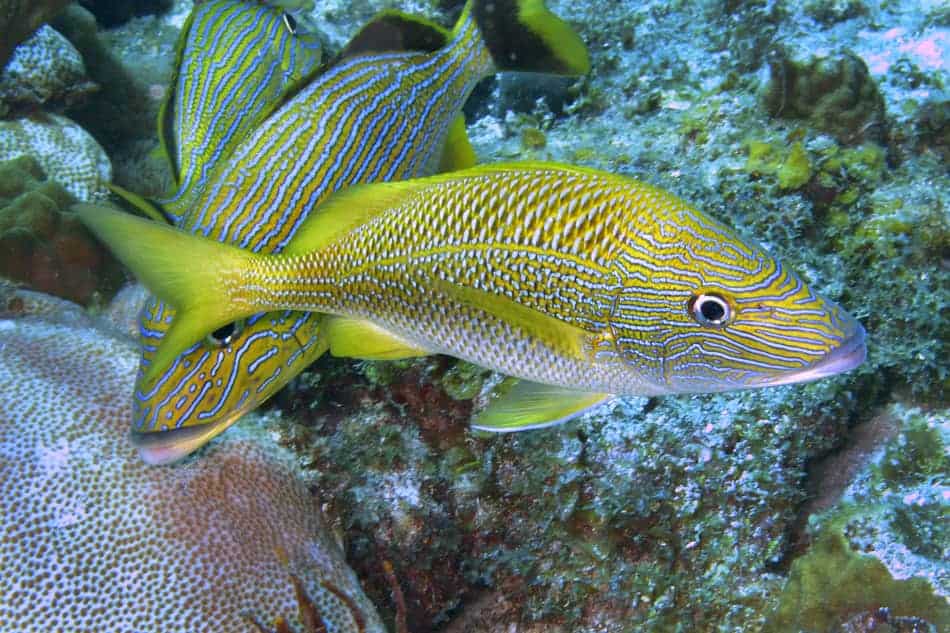
.
If you are looking for an easy family fishing adventure, fishing for Grunt maybe your best option! Grunt are easy to find and a fun fish to fight!
How To Catch Grunt
Grunt are caught near shore, bottom fishing on structures ranging from 3’ to 90’ in depth. Grunt are usually caught on small shrimp and squid, using a 1/0 circle hook and a small sinker.
Grunt are typically caught near the shore on structures such as mangroves, docks, wrecks, and reefs. Though Grunt are not picky eaters, they do prefer squid and fresh shrimp. Grunt inhabit both brackish and saltwater but prefer inhabiting the latter. Grunt are most frequently caught using 15lb to 20lb fluorocarbon leader with a 1/0 to 2/0 circle hook. Grunt travel in large schools, so once you hook into the first fish, have other anglers cast or drop-down their rigs in approximately the same area. Grunt inhabit the same regions that larger predator fish inhabit, and since grunt are caught on lighter tackle, often these larger fish will hit your bait and break you off. Therefore, make sure to bring additional tackle, there is a good chance you will be retying a couple of times while fishing.
Expert Tips On Catching Grunt
Use live shrimp & squid: Live shrimp & squid have been staples for catching grunt off reefs, wrecks, and mangroves.
Keep it shallow: Though grunt are found in varying depths, they are most frequently caught around 30’ of water.
Size matters: To increase your chances of hookup, fish with a 1/0 to 2/0 size circle hook.
Catching the small ones: Grunt are often targeted as baitfish for larger predator fish. If you are targeting smaller Grunt, the most effective way to catch them is fishing dock lights at night with a small piece of shrimp or locating a deep grass flat.
Find the schools: Grunt congregate in schools with other Grunt of approximately the same size. If you are hooking small ones, try moving a couple of feet over and fish a different area, you may run into a larger school.
Fish the bridge: Grunts are known to congregate around bridges, especially when the bridges are located close to the pass (where water is higher in salinity and more biodiverse).
Fish the changing tide: Though Grunt can be caught on any tide, they are most active when the tides begin to change.
Let’s take a deeper dive into how to catch Grunt by learning more about the species as a whole.
What Are Grunt?
Haemulon Plumierii, commonly called Grunt, are bottom-dwelling reef fish popularly found in warm tropical waters. There are over 100 species of grunt found from Virginia all the way south to Brazil. Grunt are called by many names, including Porkship, Pigfish, Sweetfish, Margate, & Red lips. Though there are many species of Grunts, the White grunt is most commonly known. White Grunt are characterized by their blueish grey bodies with touches of yellow and brown. Grunt have almond-shaped bodies, pointed snouts, and a forked caudal tail. Grunt also have a similar body type to that of other reef inhibiting fish, the most notable being Snapper. Unlike the Snapper, the grunt does not have vicious canine teeth. Instead, Grunt’s teeth are located in their throats.
When Can You Catch Grunt?
Grunt can be caught year-round, but the summer bite tends to be the hottest due to their spawning season. Though Grunt eat around the clock, they are most active feeding at night.
Where Can You Catch Grunt?
Grunt are caught in regions as far north as Chesapeake Bay, and as south as Brazil. They are bottom-dwelling fish often congregating on reefs, mangroves, docks, and other underwater man-made structures. Juvenile Grunt can be caught off mangroves and other coastal structures whereas mature grunt reaching a maximum size of 15″, are typically found out on the reefs. Grunt can be caught in varying depths but are not typically found in waters exceeding 90′. Grunt typically inhabit reefs during the day and travel out into the sandy, muddy bottom at night to hunt for prey.
What Do Grunts Eat?
Grunt are opportunistic feeders typically eating any biomass available. With that said, there are certain foods that they feed on regularly.
- Small fish
- Crustaceans (shrimp, crab, etc.)
- Annelids (worms, leeches etc.)
- Mollusk (snails, mussels etc.)
Are Grunt Good Eating?
Grunt are excellent to eat but are rarely harvested by anglers. Their flesh is comparable to Snapper being white and flaky with a mild flavor. “Grunt and grits” have become a staple in many coastal environments including Sanibel and the Florida Keys. It is crucial to mention that Grunt are moderately high in mercury and sometimes carry ciguatera.
Are Grunts Safe To Eat?
According to the CDC, Grunt have been known to carry the Ciguatera toxin that poses health concerns to humans. Large Grunts can have high levels of the Ciguatera toxin, making it wise to avoid harvesting larger fish. If you consume fish with ciguatera, you may experience stomach aches, vomiting, and diarrhea. Most symptoms subside in a couple of days but, in rare cases, can stay for years.
Are Grunts Bony?
Grunt are bony reef fish, making them difficult to fillet. Grunt’s bony bodies are one of the many reasons Grunt are not harvested as frequently as other reef fish.
Do Grunts Make Good Bait?
Grunts make phenomenal bait for larger predator fish, including Snook, Shark, Mackerel, and Barracuda. Many inshore anglers use juvenile Grunts as bait for large Snook.
Are Grunts High In Mercury?
According to the EPA, Grunts are moderately high in mercury content, with typically ppm levels around .444. To put that in perspective, the lemon shark, which is often known for high mercury levels, averages a ppm of .697, and Salmon, known for its low mercury content, comes in at an average of.039 ppm.
Are Grunt In The Snapper Family?
Grunt are not related to Snapper. Grunt are in the Haemildae family, whereas Snapper are in the Lutjanidae family.
Do Grunt have Teeth?
Grunts do not have teeth on their jaws but rather Pharyngeal teeth located in the back of their throats. These teeth give Grunt the ability to make the “grunting” sound that they are named after.
What Sound Does A Grunt Make?
Grunt make a “grunting” sound produced by stridulation, which is the act of the fish rubbing its Pharyngeal teeth together in the back of its throat. This sound is then amplified by the Grunts swim bladder, increasing the overall volume of the sound.
Do Grunt Have A Size Limit?
No, grunt are unregulated fish. In Florida, unregulated fish can be harvested at any size. The only limit being the total weight of the fish harvested. You can harvest up to 100 pounds per person.
Grunt Fun Facts
- Many divers know grunt as “the kissing fish.” Grunt can often be found on reefs touching lips. Marine biologists are not sure if this is a form of courting by the species or territorially display.
- Grunt are popular amongst the aquarium community due to the fish’s beautiful colors and small size.
- Grunt’s scientific name originates from the Greek word “hamaleos,” meaning bloody gums.
Best Fishing Tackle For Grunt Fishing.
Best Rod & Reel for Grunt
Grunt rarely exceed 15″ in length, so using a light to medium power fishing setup would be best. A perfect fishing setup for Grunt would be a 6’6″ to 7′ rod with a 3000 sized reel.
Best Fishing Line for Grunt
I would suggest a 20-30 pound power pro when targeting Grunt.
When bottom fishing, I always recommend fishing with braid instead of monofilament. Braid is a responsive line meaning your ability to feel bites and bottom structure are dramatically increased. Also, braid has little to no stretch, making it simple and easy to break the line when caught on the bottom. If you are caught on the bottom using monofilament, the stretch can make it quite difficult to break the line without cutting it.
Braid has other advantages, which include increasing the overall line capacity on a reel. Take the Penn battle 3000 for example. You can fit 165′ of 10lb monofilament on the reel, where is you can fit 180′ of 20′ braid. I would recommend a 20lb power pro on the pen battle 3000.
Best Fishing Leader for Grunt
When it comes to grunt, the smaller the leader diameter, the more action you will have. I would recommend using a 15 to 20-pound leader when fishing for grunt. The Super FC Sniper by Sunline would undoubtedly increase the amount of fish that bite. Leader length is also an important factor to keep in mind, I recommend between 5 and 7 feet.
Best Hooks for Grunt Fish
Choosing the correct size of hook for grunt fishing can drastically increase your fishing odds. A 1/0 sized circle hook works great for their small mouths. We recommend the Eagle Claw Lazer Sharp L7228 Circle Octopus Inline Hook.
Best Sinker Size for Grunt
We recommend at least a 1-ounce sinker for every 30′ of depth when targeting Grunts. If you are fishing in an area with a strong current you should add additional weight to keep your bait as stationary as possible
